Hibiscus belongs to tropical regions all over the world. They enjoy growing in warm temperatures along with a humid and sunny environment. But, can they tolerate cold weather? Let’s find out.
Hibiscus can tolerate cold weather depending on the variety. The Tropical Hibiscus will endure cold up to 50°F and sometimes 20°F but will drop leaves and become dormant in the latter. The Hardy Hibiscus plants will tolerate up to -20 to -30°F and become dormant.
There is a lot more to know on this subject. Today, I will share the cold tolerance of Hibiscus plants depending on the types and how you can protect them in winter.
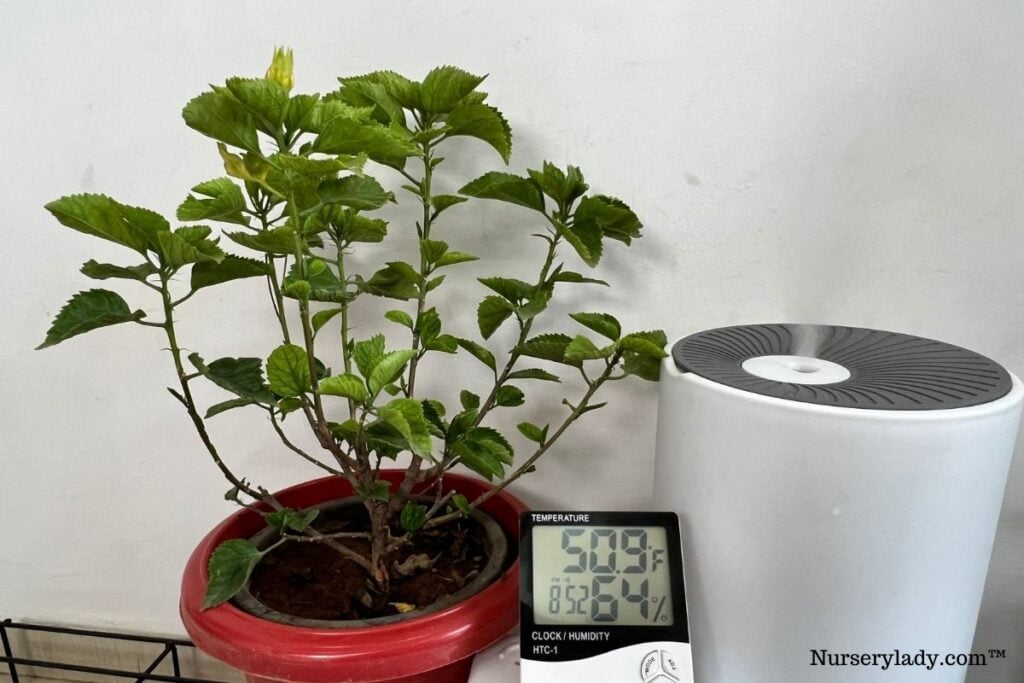
How much cold temperature can Hibiscus withstand?
There are rarely any summer-blooming plants that produce such big color flowers as Hibiscus.
You can enjoy Hibiscus blooms even during the fall.
The best temperature for Hibiscus is between 60-75°F.
It encourages enthusiastic growth and blooming.
But, sadly, Hibiscus cannot tolerate too cold weather.
Some varieties can endure it.
But most of them will go dormant if the weather is too cold.
The cold temperature for Hibiscus depends on the variety you own.
Let’s understand the temperature tolerance and the ideal hardiness zones of the Hibiscus varieties.
Tropical Hibiscus
Tropical Hibiscus plants like the Chinese Hibiscus and Confederate Rose cannot tolerate very low temperatures.
All Tropical Hibiscus plants are generally from zones 9-11.
Chinese Hibiscus belongs to zones 9 to 11.
Confederate Rose plants are from hardiness zones 8 to 10.
The average winter temperature in zone 9 is 20°F.
Tropical Hibiscus can survive this temperature.
But, they will drop their leaves, suffer branch dieback and become dormant.
Tropical Hibiscus will start dropping leaves when the temperature reaches around 40-50°F.
So, you should take this variety indoors in winter.
Hardy Hibiscus
These species are winter hardy plants and can tolerate extremely cold temperatures.
Moreover, they can endure freezing temperatures.
They are even frost-tolerant plants and can endure temperatures close to -20 to -30°F.
Both Rose Mallow (zones 5 to 9) and Rose of Sharon (zones 5 to 8) are Hardy Hibiscus plants.
But their growth habits are different.
The Rose Mallow will die to the ground in winter.
Rose of Sharon will only drop all their leaves and become deciduous.
Hardy Hibiscus plants are from zones 5 and will tolerate temperatures around -20°F.
Looking for gardening supplies? We have tested 100's of products before recommending them to you guys. Check out our best pick below:
| Image | Gardening Supplies | Best Price? |
|---|---|---|
 Top
Top Top
Top | Raised Garden Bed Kit | Check On Amazon |
 | XLUX Soil Moisture Meter, Plant Water Monitor, Soil Hygrometer Sensor for Gardening, Farming, Indoor and Outdoor Plants, No Batteries Required | No Results |
 Top
Top Top
Top | 82 Pcs Garden Tools Set and Extra Succulent Tools Set | Check On Amazon |
 | Joeys Garden Expandable Garden Hose with 8 Function Hose Nozzle, Lightweight Anti-Kink Flexible Garden Hoses, Extra Strength Fabric with Double Latex Core, (50 FT, Black) | No Results |
 Top
Top Top
Top | Dual Chamber Compost Tumbler | Check On Amazon |
 Top
Top Top
Top | Sunnyglade Plant Stakes | Check On Amazon |
 Top
Top Top
Top | Organic Cold Pressed Neem Seed Oil | Check On Amazon |
 Top
Top Top
Top | Mighty Mint Gallon :-Insect and Pest Control Peppermint Oil | Check On Amazon |
 Top
Top Top
Top | Scotts DiseaseEx Lawn Fungicide | Check On Amazon |
 Top
Top Top
Top | Jacks Classic 20-20-20 All Purpose Fertilizer | Check On Amazon |
 Top
Top Top
Top | 30,000 Seeds Pollinator Attracting Wildflower Mixture | Check On Amazon |
 Top
Top Top
Top | Survival Vegetable Seeds Garden Kit-Over 16,000 Seeds | Check On Amazon |
Will Hibiscus plants tolerate frost?
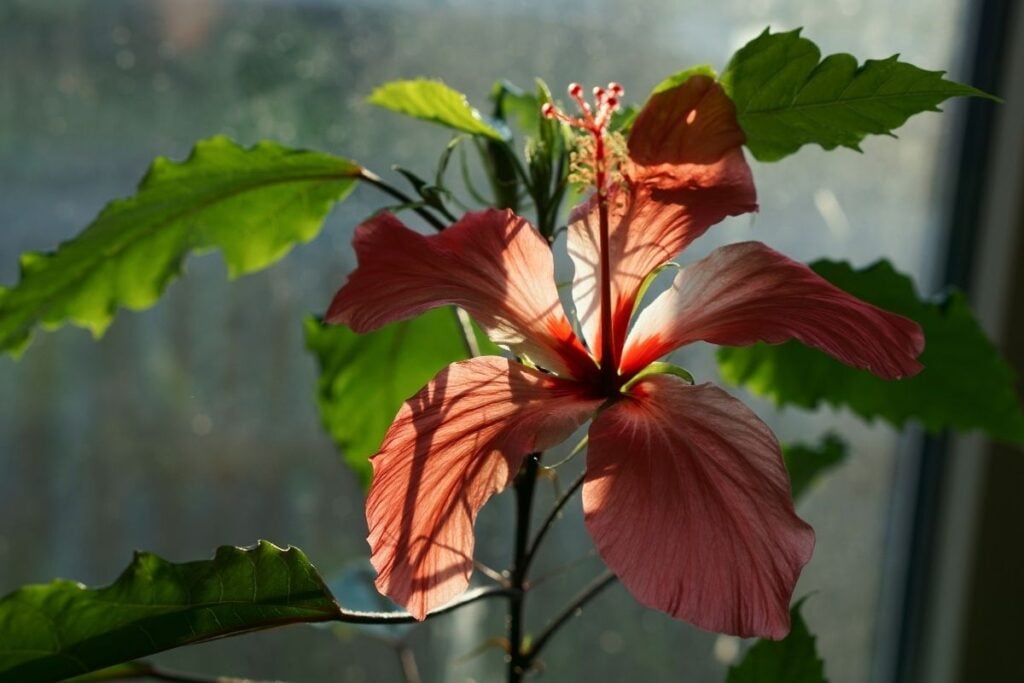
Not all the Hibiscus varieties will tolerate frost.
As I mentioned before, only the Hardy Hibiscus will tolerate temperatures below 0°F.
Tropical Hibiscus can withstand cold temperatures but not freezing ones.
The plant will suffer bad frost damage if left outside in freezing temperatures.
Hardy Hibiscus can tolerate frost as they are native to zones 4 to 8, where average temperatures are -20°F.
So, if you live in such a region where winter gets frost, your Hardy Hibiscus will stay outside without any issue.
But, of course, protection is important.
When should I bring my Hibiscus plant inside?
You must bring the Tropical Hibiscus plants inside as they are frost-tender plants.
They will die if left outside in the cold winters.
The leaves will begin to drop when the temperature reaches 40°F.
When you see the plant dropping leaves, it is time to take the Tropical Hibiscus indoors.
Make sure to move them inside before the nighttime temperature of your living area goes below 50°F.
Otherwise, your plant will suffer frost damage.
Can I keep Hibiscus outdoors?
If your living region receives cool winter and the temperature doesn’t drop below 55 to 60°F at night, you can keep the Tropical Hibiscus outdoors.
However, if you belong from freezing areas, you can grow and keep Hardy Hibiscus outdoors, with some protection.
Types of damage
Whether you live in a warm climate or cold climate, Hibiscus will receive cold damage in both situations.
The plant will get two types of damage:
- Frost damage
- Freeze damage
The level of damage will help you identify which one your plant is facing.
Frost happens when the temperature goes below 32°F at night.
The cold air trapped in the ground will make the plant lose the moisture they absorbed throughout the day.
It will slightly warm up the air above the plant and create ice crystals on the leaf surface.
The water inside the leaves and flower of Hibiscus will freeze when the temperature drops below 20°F.
The cells inside the leaf burst and create a damp black mark, an evident sign of freeze damage.
What are the signs of damage in Hibiscus plants?
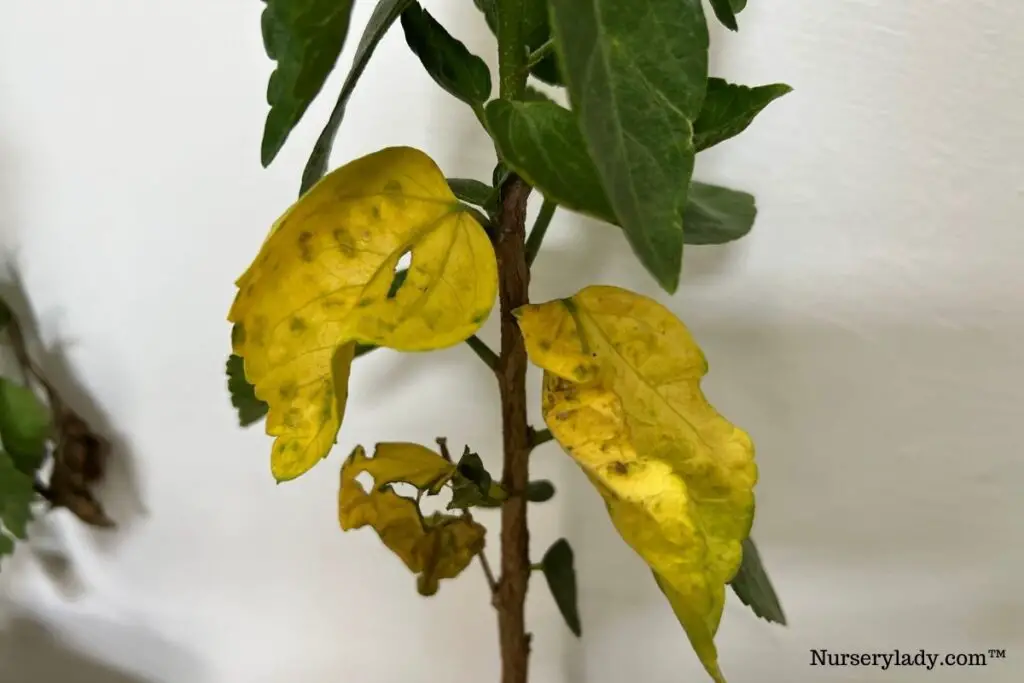
If you are unaware of the plant’s cold tolerance and don’t protect your Hibiscus plant from frost or freeze, the plant will show certain signs to tell you that it cannot take such cold temperatures.
In frost damage:
- The leaves and flower buds will have brown edges and spots.
- The leaves will shrivel and look water-soaked
- They will turn brown and black all over.
In freeze damage:
- The leaves will wilt and become purplish brown or black
- The buds will become wilted and slimy
- The stems will freeze from top to down, from the soft and new ones to thick and old ones.
Though the Hardy Hibiscus can tolerate frost, you should still protect them in winters to keep them warm.
And, it is compulsory to protect the Tropical Hibiscus the moment you find any initial signs of frost.
Otherwise, the plant will die.
However, it is always possible to revive the plant back.
To kill the plant from the roots, Hibiscus needs to be exposed to deep and continued cold climate.
So, don’t think that cold injury means the death of your plant.
I will share the steps to fix a frozen Hibiscus in the next part.
How to treat a Hibiscus plant from cold injury?
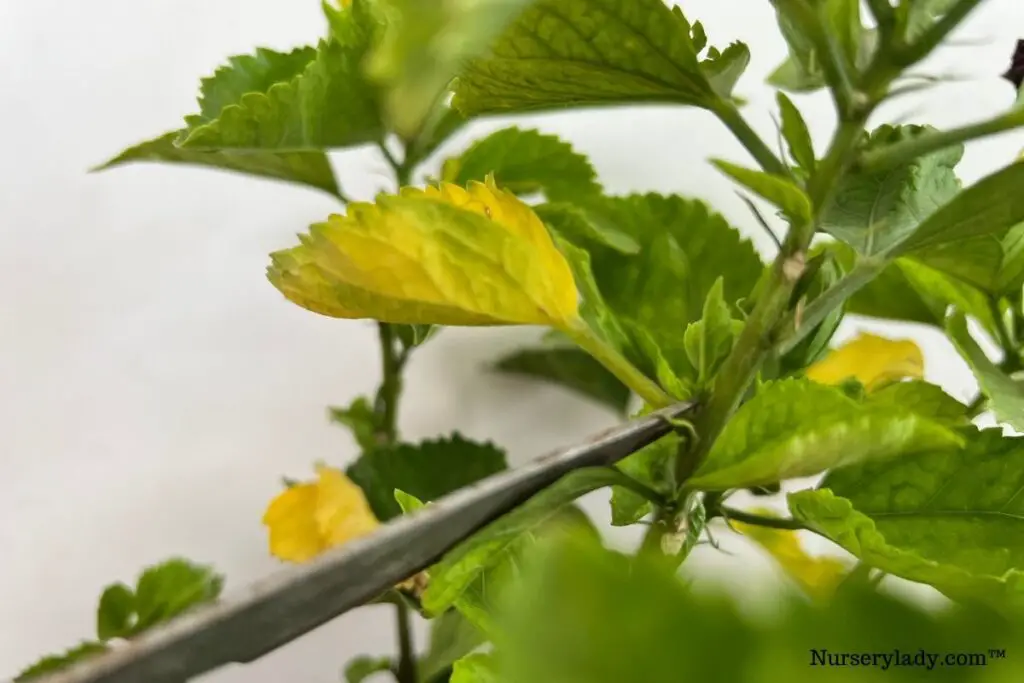
To fix a frost damage plant, you have to wait until the risk of frost passes instead of taking any immediate action.
This means you have to let the plant out as it is outside until winter is over.
The frost-injured branches will insulate the plant or the buds against any other damage from the cold weather.
To correct the frozen plant, you need to prune off the dead leaves and branches once the frost goes away.
Here are some steps to prune a frostbitten plant:
- Scrape with your finger or use a knife to scratch and check whether the branches are dead or not.
- Check from the end of the branch and start scratching it to look at the tissue. If the tissue looks brown, the portion of that branch is dead.
- Continue this up to the trunk until you see any green tissue under the bark. Green tissue means it is a live wood.
- Find how far the live wood lasts, and find the next flower bud and leaf node.
- Prune off the rest of the branch, ¼ inches above the node on the live tissue.
- Repeat this for each branch.
- Cut off the damaged leaves in the spring when the stem is green and undamaged.
- Also, remove the stems in the early spring, a minimum of 1/3rd of the plant, before any new growth.
- Cut ¼-inch above the leaf node at a 45° downward angle. If you are cutting close to the ground, leave 2-3 nodes behind for new growth.
How should I take care of Hibiscus plants in winter?
Since Hibiscus has two varieties, the winter care tips will vary depending on the variety.
It will also differ if you are from a warmer climate.
Following the right winter care guide will prepare your plant to outlast winter.
Let’s take a look at the tips.
Taking care of tropical Hibiscus in winter in colder climates:
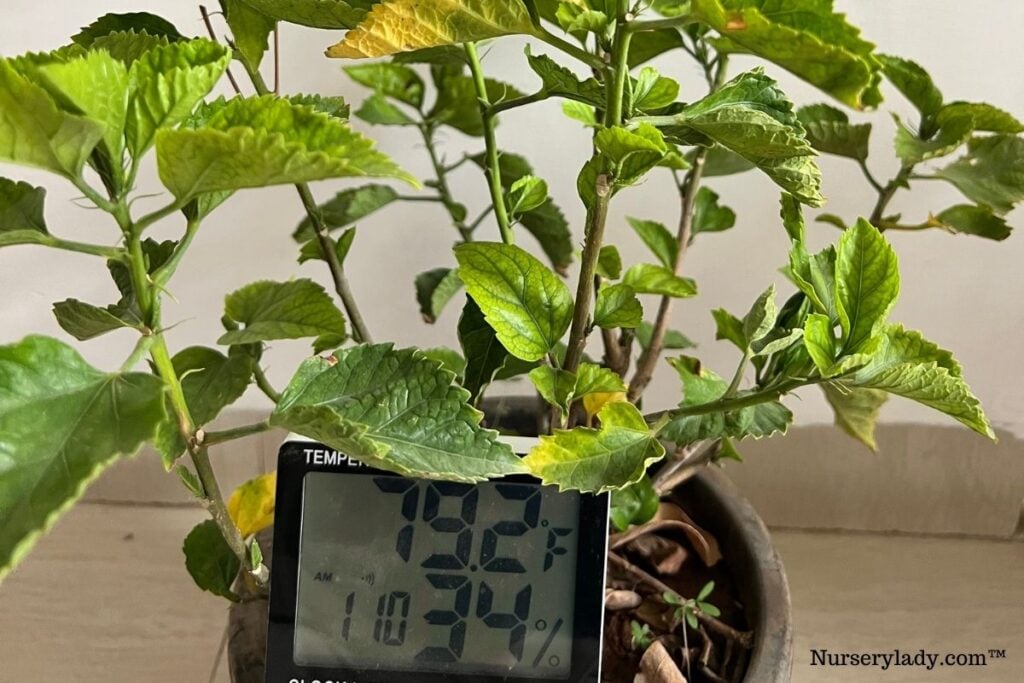
Grow Hibiscus in containers for bringing them inside in winter.
If it is in the ground, dig it up in autumn, transfer it to a pot, and then indoors. Avoid garden soil this time.
- Before bringing it inside, wash the plant with a garden hose to remove all the bugs from the plant. If you bring an infected plant inside, it can affect the other good plants. Wash them 1-2 times per week for 2-3 weeks before you plan to take them inside.
- During the last wash, mix some horticultural oil into the water and spray the plant thoroughly. The last spray with horticultural oil will eliminate all bugs and prevent a further visit.
- You can also prune off the plant by 30%, but it shouldn’t be heavy. For heavy pruning, wait for the next spring.
- Shift them indoors and maintain temperatures above 40-50°F. 65°F would be best. Keep them near the sunniest window for sufficient sunlight and warmth. Use artificial lights.
- You can keep the plant outside in the morning for enough sunlight. Bring it inside in the evening before the temperature drops below 50°F.
- The indoor temperature should not go below 55-60°F. Increase humidity with the help of a humidifier, pebble trays, water trays, or group planting. This won’t let them go dormant.
- Water the plant rarely, only when a few inches of the topsoil is dry. Ensure that the pot has drainage holes and empty the saucer from time to time.
- If you see that the plant is losing leaves, it is going dormant. Move your plant to a dark place unless you find any new growth. Don’t fertilize at this time. Since they are sleeping, they won’t use any nutrients. Fertilize again in the early spring.
- Once you see any new growth, move it outside under the sun and start regular watering. Expect fresh growth in late February or March.
- There are fewer chances of dormancy for Tropical Hibiscus indoors. In that case, fertilize, but in little amounts. Without fertilization, the plant will be deeply dormant, and coming out of it won’t be easy.
Taking care of Hardy Hibiscus in colder climates:
You don’t have to bring the Hardy Hibiscus inside.
Since they are native to colder zones, they can tolerate temperatures close to -20 to -30°F.
- Prune the plant when the first frost is on its way. Either cut off the old growth around 1 ft. or down to the ground.
- Apply a thick layer of mulch, about 8-10 inches, around the plant base. This will trap the warmth and moisture and prevent the cold from reaching the roots. Use chopped leaves, pine needles, or compost.
- Let them have sunlight the whole day to have a warm temperature.
- Cover the plant with frost cloth to prevent the frost from touching them in the evening.
- You can fix some artificial light under the frost cloth. Turn it on during cold nights to keep the plant warm.
- Though hardy, they will be dormant and die to the ground when a strong frost climate arrives. You will find a bunch of new leaf growth after 3 months. Don’t fertilize during dormancy.
- Use these methods for taking care of Tropical Hibiscus in warmer climates, where the winter is mild and not freezing.
Note: These steps are applicable for the Hibiscus trees as well.
Winter Aftercare
If you follow the winter care guide, your plant will stay fine and outlive the rough winter.
Once the winter is over, follow the aftercare measures to prepare the plant for spring growth:
| For Tropical Hibiscus | For Hardy Hibiscus and Tropical Hibiscus of warmer climates |
|---|---|
| Bring your tropical plant outside once the temperature warms up and rises above 50-55°F, bring your tropical plant outside. Shift your plant to a sunny spot to watch them grow and bloom. | Remove the frost cloth and mulches from the plant and plant base. |
| Remove the dead leaves and branches from the plant. | Let them have the direct sunlight now. |
| Check the soil moisture and water if it is dry. | Add some organic fertilizer to help them come out of dormancy. It will promote new growth and blooms. |
Final words
If you belong to warmer climates, you can grow Tropical Hibiscus outdoors. Otherwise, take them inside the house in the cold.
You can keep the Hardy Hibiscus outside as they can tolerate cold.
Outside, protect the Hibiscus by covering them with frost cloth and adding an 8-inch layer of mulch. Water only if the soil is dry. Don’t fertilize if they are dormant.
If you have taken Tropical Hibiscus indoors, water them when the soil is dry, and you can fertilize them if they are not dormant. If the plant got frostbite, wait to remove the damaged leaves and stems once the frost is over.
Once the winter is over, take the indoor plant outside. Remove the frost cloths and mulches from the outdoor plants’ base. Start with normal watering and fertilize in the early spring to bring them out of dormancy.
Reference: Wikipedia, ASPCA, Louisiana State University Agricultural Center, American Society for Horticultural Science, Tropical Hibiscus by Texas A&M University, Sciencedirect.
